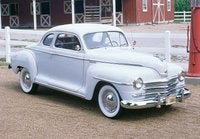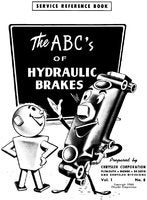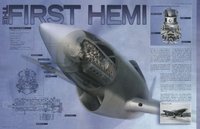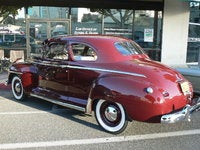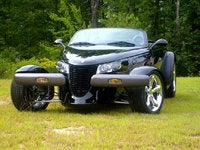The brake lights on my 1947 Plymouth Special Deluxe Coupe have stopped, I replaced the bulbs with 1154 LL. I have replaced some of the fuses too, what else could it be?
I had the electrical wiring replaced a few years ago. One day the brake lights stopped working, I thought
it might be a bulb so to be safe I replaced them all with bulb #1154LL, I did convert to a 12V system.
Any ideas? I also replace the fuses but no luck, I don't want to take it to a shop because it may be
something simple and I am just getting frustrated. Thanks for the help.
Big Al.
17 Answers
Being the wiring isn't all that complicated I'd start at your back tail lights and start checking the wires themselves, it really could be a number of things and then being a conversion over to 12v, a lot depends on how it was done and if a aftermarket harness was used or straight wire. I would have to go dig out some manuals which would be somewhat troublesome but not impossible. The conversion though makes those frankly useless. You might check down at the brake pedal for a switch that activates when you press on the break pedal. Great car by the way, and I will go pull out those dusty books if you need me to. Put start at the brake pedal and look for that switch that activates the brake lights. If it's original, it is more than likely worn out.
Glad I didn't put to much effort into this, haven't heard anything back, put that's kind of typical on this site. But anyhow, I found what I was looking for....
ilRegal, this car might have a pressure switch that closes when hydraulic pressure is applied. -- The 50's Studebaker's had them and they would drain the battery when winter brought on single digit temperatures. The cold would contract the tubing and the brake lights would come on in the middle of the night.
Hey Tenspeed, that's a great thought and I wouldn't have thought of that and I do recall what you mentioned. However and like you mentioned I think it caused the lights to stay on, he's saying they won't come on. The trouble or some of them with the Imperial post war years of 46-48 was the parts themselves. If you had a 48 you could actually have parts from the 46 production year or 47 or 48. You never knew for sure. Everything production wise was all screwed up due to war years manufacturing and every company had some role in the manufacturing of something related, so the actual production lines of parts weren't up to pare yet and back in sync with the year manufactured. It makes it really hard to get the exact year specific part, though it really made little difference obviously as the car hardly changed at all through the war and remained that way up to and about 1950 or so. I have this big box of Imperial tech manuals and bunches of other stuff I have gathered over the years and pulled out an old poster from Chrysler that was show casing the very first Hemi, which was a 16 cylinders supercharged inter cooled aircraft engine. It never went into production put produced around 2200 HP. Kind of neat and the production design started in 1942 and the first Chrysler Hemi for cars came out in 1950 I think. Thought that was interesting. I have some Studebaker stuff I will look at if I have time today just to see about that regulator. But with this situation, it could be so many different things, and I believe the brake light actuator would have had to have been updated to match the 12v conversion, but who knows.
Sorry about that I don't know why I started talking about the Imperial, maybe because I like them?? Or it's to early in the morning, beats me.
A possibility: Standard Ignition - Brake Light Switch Fits Your 1948 Plymouth P15 Deluxe Part # SLS27T
You mentioned a switch on the brake pedal to check for power. If the car had a hydraulic system the pressure switch would be somewhere inline, presumably in the engine compartment near the master cylindar out of the elements.
Well, on this car was talking about the electrical switch to activate the brake lights like the one mentioned above your last post, but it kind of looks like we are only talking to each other....LOL.... seems like we all do that a lot here. Person ask a question, I spend two hours looking for the brakes tech manual and all the time thinking I'm helping somebody out and never hear a word back. Oh well, what's new Tenspeed. I guess we should be used to it. I am curious about what your mentioning about that pressure module, I remember something but like I'd mentioned I think this was 50's innovation, 46-48 and even to 1950 was hell for car and parts and not much in new inventions being post war and the tooling was still changing from war years, so cars like this 48 had parts that were for the 46 even earlier. This was that way for all makes due to the war.
Thanks guys, I will check those out and get back to you. I do have a repair manual, but it doesn't show the brake pedal switch. I have just received a parts list book that may have an exploded view of the whole thing, wish me luck guys.
Thanks Batman, and if you need that hydraulics manual I've got it scanned. 46 through 48 were especially strange years for parts as were all post war cars, tooling was mostly still geared towards making war parts and not much for cars, so the 47 and 48 were still using parts from 46 and earlier. You probably knew that, but sometimes trying to match parts numbers can get weird and make you scratch your head. Been there.. thanks and I'm sorry for the out the side of neck comments, thought we'd lost you... guess not. I also found a bunch of other stuff related to these years, most makes out of the dust pile.
My first though was the bulbs you used. Most brake lamp bulbs would be either an 1157, if dual filament and twinned with the tail lamps, or an 1156 for ones that are stand alone. As for why both failed at once, chances are it is the switch, which should be an in line pressure switch, mounted somewhere just down stream of the master cylinder. When the conversion was done to 12 volts, did you stay with positive ground, or change that to a standard negative ground system? Check the grounding wire for the brake lamps, too. That can look fine, but the connection to the body can be corroded and lose.
@llregal, thanks for the help. I might take you up on that manual you scanned. Sorry I take so long to get back to you guys, but I'm now the proud Grampa of twin girls. @Michael I am running down that very piece of advice. This site has been great, but it is only a reflection of the people on it, thank you all. I'll get back soon, I am going to add a picture of Miss Scarlett for you to see.
Alright! it was the brake switch located just where you said between the brake pedal and master cylinder. It was the wire, but I didn't inspect it thoroughly and it was frayed at the pedal end hidden. Thanks to all of you for your input, can't even attempt to thank you properly. You guys are the best. IIregal, Tenspeed and Michael I really appreciate your info. Take care guys, I will send pics of the next show I enter. Oh, Miss Scarlett is a daily driver too, I just can't deny the world to see how real cars should look (just kidding). Keep in touch guys. I will definitely come back to this site. My email address is al_bert13@hotmail.com if you ever want to send a message. Thanks again. P.S. in case your wondering, I have had eight back surgeries and it kind of prevents me from getting down under, but I did it.
I'm glad you were able to get Miss Scarlet back to operational! It is wonderful to see these old cars USED as proper vehicles! After all, that is what they were designed and built to be! Oh, did you see the story about the 1928 Rolls Royce that was a graduation present to a certain young man? He owned it until his death in 1996, at age 102. It was his daily driver for 78 years! Well over 1,000,000 miles on the car at last count! They really don't build them like they used to!
I am also pleased that it was as I mentioned in "my post, the very first post" that it was the brake switch. Of course it couldn't have been to much more, by your explanation of the problem, and I basically read the manual for your year with the wiring diagram that I have for every year of this model coupe. It certainly couldn't be the bulbs as where Micheal's brain tried to start working with which shows he to doesn't bother to read any previous post before commenting or does and is just a parrot and I generally give the question asker more credit and common sense thinking than that idea as if you might not be smart enough to thinks bulbs first before asking for assistance. By the way congratulations on the wonderful addition to your family or I should say additions!! Being I know Michael loves to take credit and doesn't bother with seeing what has already been posted which is fine, if you go back to my fifth post I also gave you the switch part number for the replacement switch and I have also mentioned to you the difficulties in getting the correct parts for an original restoration especially in the years post war, about five posts up. Why do I know this? Because I have done so many complete restoration I can't honestly remember how many, it's my business and not a hobby or a guessing game as is the case for so many people on this site, and the one thing I certainly can't do is force people to read what I am trying to suggest, so good news for you Michael, this will most likely be my last attempt in trying to give people free professional advise and hours of seemingly wasted time it's pointless, could have been resolved in three posts, good luck
@IIregal, Thanks for the info. Yeah, I re-read the post and sure enough you mentioned it and also gave the part number. I usually try to find the original parts, but sometimes I have to use after market items. When I do use them I try to get them from NAPA auto, they have been really good and at least one or two in the shop can still remember that cars came with real chrome bumpers. I appreciate all the help. Take care and enjoy the beauty of old Detroit art that rolls on America's roads. I really can't say how much I appreciate everything.
